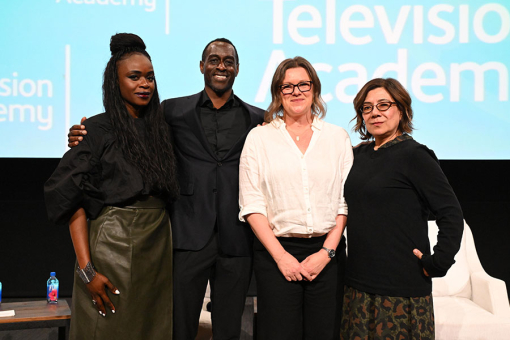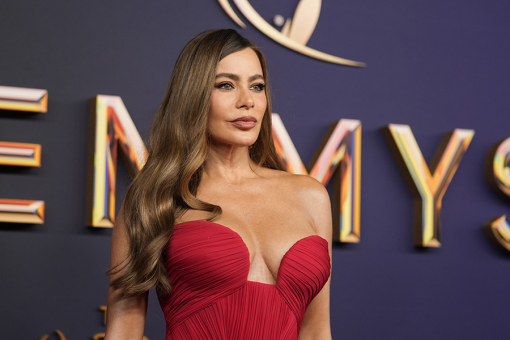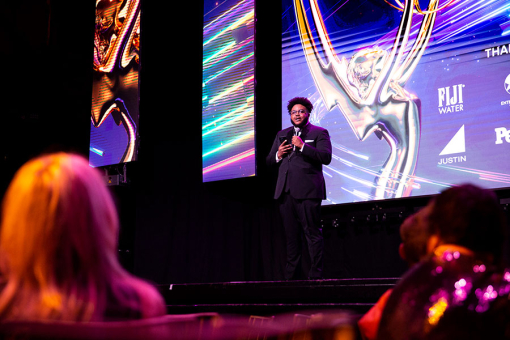The day after the 67th Annual Emmy Awards, the Los Angeles Times ran a front-page “Calendar” section photo of Peter Dinklage accepting his statuette for outstanding supporting actor in a drama series, for HBO’s Game of Thrones, presented by Viola Davis.
The photo depicted three of the diversity categories counted by SAG-AFTRA: Dinklage, as a little person, is among people with disabilities, though he’s certainly able enough at his craft. Davis is African American and a woman over 40.
Fifteen minutes after that image was taken, Davis would make history as the first African American to win an Emmy for outstanding lead actress in a drama series, for ABC’s How to Get Away with Murder.
Fittingly, this year’s Emmy Awards was noted as the most diverse Emmys ever. Before that ceremony and the preceding Creative Arts Awards had even taken place, the Television Academy had held the third annual “Dynamic and Diverse” Emmy Celebration to recognize and applaud the diversity of nominees, before and behind the cameras.
Photo Gallery: 2015 Dynamic and Diverse Emmy Celebration
Co-hosted as in previous years with SAG-AFTRA, the reception took place on the elegant third-floor terrace at the Montage Beverly Hills. Some 360 guests gathered to celebrate the nominees, discuss the strides made for greater diversity over the past year and dine on Chinese and Japanese cuisine and passed hors d’oeuvres.
Nominees included performers Richard Cabral, up for outstanding supporting actor in a limited series or a movie for ABC’s American Crime and Anthony Mendez, nominated for outstanding narrator for CW’s Jane the Virgin; Shelby Stone, nommed for outstanding television movie as an executive producer of HBO’s Bessie and Salvador Perez of Fox’s The Mindy Project, recognized for outstanding costume design for a contemporary series, limited series or movie. (Stone would go on to win.)
Other performers attending included Louis Gossett, Jr., Daniel Dae Kim, Garcelle Beauvais, Tichina Arnold, Anne-Marie Johnson, Jamie Brewer and Navid Negahban. Producers, writers and network and studio executives were also on board.
Marcelino Ford, co-chair of the Academy’s Diversity Committee with Hayma “Screech” Washington, welcomed the crowd.
“In 2015, discussions about race, ethnicity, gender, physical abilities, sexual orientation, diversity and inclusion are relevant now more than ever,” he said. “Much progress has been made in this area, both in front of and behind the camera. But we still have a long way to go.
"We’re here tonight to celebrate this year’s Emmy nominees, whose accomplishments are as impressive as the roles they have played onscreen, and the creativity they’ve produced from behind the camera.”
Jason George, chair of the SAG-AFTRA Diversity Advisory Committee, then took to the podium. He recalled that at last year’s event, he had listed upcoming new shows that featured diverse casts, such as ABC’s black-ish and Fresh Off the Boat, and had expressed hope that the shows would be successful, so that failures wouldn’t be attributed to that diversity.
“Well, a year later, the Emmy nominations have come out, and we don’t have to worry,” he said. “American Crime – 10 nominations, [for] a show that’s actually about racial conflict. Empire gets [three] nominations, and Transparent gets 11 nominations.” [black-ish received one.]
“Once upon a time,” George continued, “there were no women nominated in directing categories. Now there are seven. A black demographic was a niche market. Women were a niche market. A lot of networks got built that way. But today, diversity is not how you build a network – it’s how you maintain a network. Diversity is no longer a niche. Diversity is mainstream.”
George wanted to keep the diversity discussion going: “Keep talking after you leave the event,” he requested of the attendees.
One guest, actress Lisa Vidal of BET’s Being Mary Jane, has been a steady part of the conversation, on hand for all three receptions.
“I do see a big push for improvement, especially in the past pilot season – to create more diverse pilots, especially in cast ensembles,” she said. “And I’ve seen an increase in the quality of the roles. I think the biggest struggle is to encourage that so it’s the norm, not just a once-in-a-blue moon thing.”
And while BET started as a niche network, Vidal has observed a push among network and studio executives, as well. “I see them being more open to more diverse writers and characters. We still have a way to go, but doors are opening,” she said. “It’s a step in the right direction.”
Actor Danny Arroyo, a co-star of a Latino-themed drama series, Sangre Negra, which he is hoping to bring to television, noted that the show has an “ethnically ambiguous” casting policy.
“The character can have any ethnicity,” he said, depending on the actor deemed the best for a role. As castmate Sandra Santiago pointed out, “We have to see society as it is now. We are different colors, have different accents, different faces, different understandings. But we all just want to entertain people.”
Louis Gossett, Jr., recently experienced that spirit first hand. “I did [BET mini-series] The Book of Negroes in South Africa,” he said. “It was magical. We all did whatever it was we had to do. We all worked together – whites, browns, Africans.”
It’s not just ethnicity that should be open when it comes to casting, noted Jason Stuart, national chair of SAG-AFTRA’s LGBT Committee, who is openly gay.
“We are actors,” he said. “We want the opportunity to be treated the same way as our straight counterparts. So it’s not about whether the character is gay or straight, or bisexual, or trans – it’s about whether we get the opportunity to play it. We want to compete in the same arenas as our counterparts.”
Stuart, who was attending the reception for the first time, found it “lovely. It creates community. We ‘ve got to be able to meet each other and know that we’re around.”
Garcelle Beauvais was also attending her first Dynamic and Diverse reception. “I’m elated,” she said, “that we are being celebrated. You can’t portray the world as it is unless you have diversity.”
Nor can you accurately depict the stages of a woman’s life. “When I started in this business, if you had 40 anywhere near you, you never worked,” Beauvais said. “Now we’re being embraced ad celebrated. You can’t portray life without living it. It’s amazing that Hollywood has caught up to what we already knew.”
One executive who never needed to catch up is Karen Horne, vice president of Programming, Talent Development and Inclusion at NBC Entertainment and Universal Television Studios, who is charged with increasing diversity in front of and behind the cameras. That includes developing programming of diversity and ensuring that shows employ diverse writers, directors and actors.
“It’s easy for me, because it’s part of our DNA,” Horne said. Numerous company executives are ethnically diverse, and “our head of entertainment [Bob Greenblatt] is gay. We don’t have to convince our colleagues. We recognize that diversity is good business. And we don’t want to be outdated. My children’s friends are not all one color.”
The event exceeded Ford’s expectations, he said in an interview a few days later. “There’s a need for this event, given all the groups, and all the strides that have been made. It provides hope to people that you, too, can be recognized, and succeed, at that level.”
The nominees and others who have been successful in television are role models for the college students and recent graduates chosen for the various educational programs of the Television Academy Foundation, he noted, where diversity has long been a mandate.
As for the Academy’s co-host, the reception “has become such an important event to the union as well as to the Academy,” said SAG-AFTRA Los Angeles executive director Ilyanne Morden Kichaven.
“People really make the time to be there. It’s becoming a passion – we had many producers, writers and showrunners there, people from How to Get Away with Murder and Fresh Off the Boat. It’s a very symbiotic relationship with the Academy, to have the creative people behind the camera, and the people who have so much to say on camera.”
Perhaps someday there won’t be a need for such an event. At the reception, TV executive Horne’s perspective about her children having a variety of friends was affirmed by one of the child performers who attended.
As Fresh Off the Boat youngsters Forrest Wheeler, Hudson Yang and Albert Tsai cavorted nearby, actress Amy Anderson, mother of ABC’s Modern Family’s Aubrey Anderson-Emmons, asked her daughter if she knew what “diversity” was.
“No,” the little girl replied.
“I love that she’s eight, and she doesn’t think of diversity,” mom Anderson said. “She’s growing up in Southern California, and for her generation, people are just people.”











